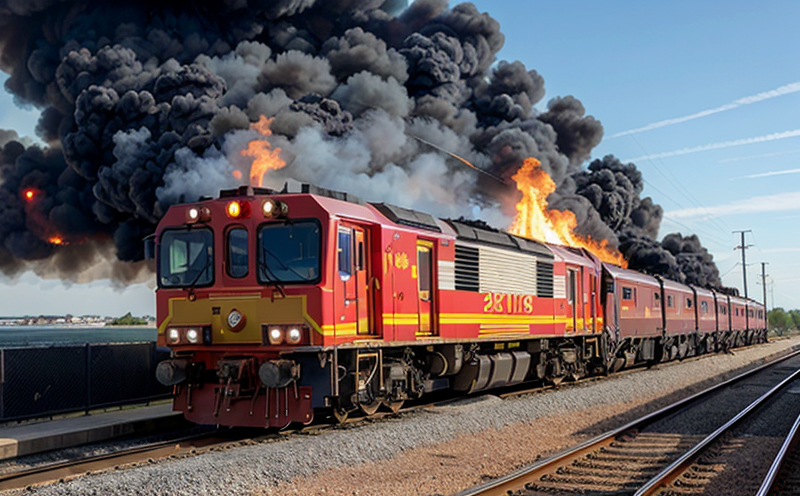Reaction-to-Fire Testing of Railway Upholstery Fabrics
The reaction-to-fire testing of railway upholstery fabrics is a critical aspect of ensuring passenger safety and compliance with international standards. Fire incidents in public transport, especially railways, can have devastating consequences. This test evaluates how fabrics react to fire, providing crucial data on flammability, smoke production, and heat release rates.
The primary goal of this testing is to determine the suitability of materials used in railway upholstery for use in public transportation systems. The test simulates real-world scenarios where fabrics may come into contact with an ignition source or be exposed to fire. By conducting this test, manufacturers can ensure their products meet stringent safety requirements and contribute to a safer travel environment.
The testing process involves carefully selecting specimens of the fabric in question. These specimens are then subjected to controlled burning under specific conditions that mimic potential real-world situations. The apparatus used includes an Ignition Source, Heat Release Rate (HRR) calorimeter, and Smoke Production Measurement System. Each component plays a vital role in accurately assessing how fabrics perform when exposed to fire.
The test results provide detailed insights into various aspects of fabric performance, including flame spread, smoke density, heat release rate, and carbon dioxide production. These metrics are essential for evaluating the safety characteristics of railway upholstery fabrics. Compliance with international standards such as ISO 17692-1:2014 and EN 458:2016 ensures that the tested materials meet the highest safety standards.
Understanding these test parameters is crucial for quality managers, compliance officers, R&D engineers, and procurement personnel involved in railway upholstery development. The results of this testing help ensure that the fabrics used are not only safe but also contribute positively to fire safety measures on railways. This knowledge can be applied to improve product design, enhance passenger safety, and meet regulatory requirements effectively.
- Flame Spread: Measures how rapidly a flame spreads across the surface of the fabric.
- Smoke Density: Quantifies the amount of smoke produced during combustion.
- Heat Release Rate (HRR): Indicates the rate at which heat is released by the material as it burns.
- Carbon Dioxide Production: Assesses the quantity of carbon dioxide generated during the burning process.
Why It Matters
The importance of reaction-to-fire testing cannot be overstated, especially in sectors where public safety is paramount. Railway systems serve millions of passengers daily, and any fire incident can have catastrophic consequences. Ensuring that the upholstery fabrics used meet rigorous fire safety standards helps prevent such incidents and protects lives.
Compliance with international standards like ISO 17692-1:2014 and EN 458:2016 is not just a legal requirement but also a commitment to passenger safety. By adhering to these standards, railway operators demonstrate their dedication to maintaining high safety standards across all aspects of operation.
The results of this testing play a crucial role in decision-making processes related to material selection and product design. They provide valuable data that can influence the development of safer, more resilient fabrics for use in railway systems. This information is invaluable for quality managers, compliance officers, R&D engineers, and procurement personnel involved in these critical decisions.
In summary, reaction-to-fire testing ensures that railway upholstery fabrics are safe and reliable, contributing significantly to overall fire safety on railways. It helps protect passengers and staff by preventing potential hazards and ensuring regulatory compliance.
Why Choose This Test
- Comprehensive Evaluation: The test provides a holistic assessment of fabric behavior under fire conditions, encompassing flame spread, smoke density, heat release rate, and carbon dioxide production.
- International Compliance: Results ensure compliance with international standards such as ISO 17692-1:2014 and EN 458:2016, enhancing the credibility of products in global markets.
- Promotes Safety: By identifying potentially hazardous materials early in the development process, this test helps prevent accidents and injuries on railways.
- Enhances Reputation: Demonstrating commitment to safety through rigorous testing can strengthen brand reputation among passengers and stakeholders.
International Acceptance and Recognition
The reaction-to-fire testing of railway upholstery fabrics is widely recognized and accepted across the globe. The international standards mentioned, ISO 17692-1:2014 and EN 458:2016, are respected by regulatory bodies and industry professionals worldwide. These standards provide a uniform framework for evaluating fabric performance, ensuring consistency in testing protocols.
Many countries have adopted these standards to enhance fire safety measures in public transportation systems. By adhering to these international norms, railway operators can ensure that their products meet the highest safety benchmarks and are suitable for deployment across diverse geographical regions.
The acceptance of these tests extends beyond mere compliance; it also fosters a culture of continuous improvement. Manufacturers and researchers use the results from these tests as a benchmark for innovation and advancement in material science, contributing to safer and more efficient railway systems.





